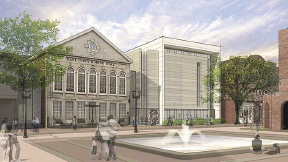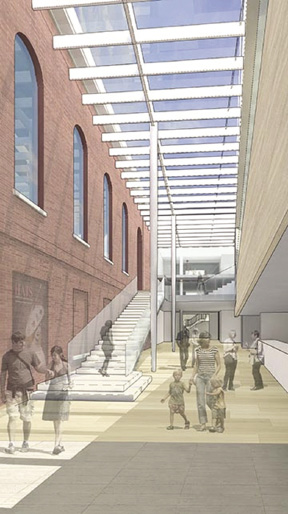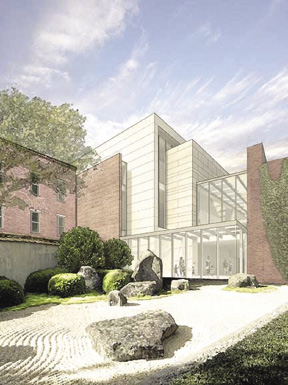The Peabody Essex Museum (PEM) has released an updated expansion and facilities plan, an array of infrastructure improvements and new programmatic initiatives as elements of PEM's landmark $650 million Advancement Campaign, one of the largest art museum campaigns in the country.
"PEM's Advancement Campaign defines a new model for museum finance, fundraising and operations. The updated plan emphasizes long-term financial stability through substantially increased endowment. By right-sizing facility and infrastructure investments, PEM gains a rare degree of freedom to advance our mission through sustained innovation and focus on new and enhanced programmatic initiatives," said Dan Monroe, the Rose-Marie and Eijk van Otterloo director and CEO of PEM.
Sam Byrne and Sean Healey, co-chairs of PEM's board of trustees said, "We balanced priorities for this Campaign by allocating $350 million to endowment, $200 million to facility expansion, and $100 million to various infrastructure improvements. To maintain these priorities we have restructured expansion plans to meet our highest priority facility needs, avoid overinvestment in bricks and mortar, and maintain our commitment to long-term financial sustainability and programs."
EXPANSION PROGRAM
Based on initial work with Rick Mather Architects and subsequent work with Richard Olcott/Ennead Architects to thoroughly analyze expansion options and costs, the museum will construct a new 40,000 s/f wing for galleries and a new 80,000 s/f off-site Collection Stewardship Center.
Groundbreaking for the new 40,000 s/f wing will take place in 2016 and the new wing will open to the public in 2019. Rising three stories and adding a facade to the Essex St. pedestrian way, PEM's new wing will be designed to clarify, unify and enhance the older sections of the museum while providing new galleries dedicated to presentation of portions of the museum's extensive collection. The building site occupies the northwest corner of the museum complex where the Asian Garden currently resides. No existing galleries will be demolished in the building process and when the project is complete, gallery space will be increased by 15% to bring total gallery space to 100,000 s/f, ranking PEM among the top 20 art museums in the country.
A design highlight of the expansion will be the renovation of the west facade of the museum's founding structure, East India Marine Hall. This National Historic Landmark will be given renewed prominence with the creation of an adjacent two-story glass atrium that will offer fresh perspectives on this iconic building. The new wing will also provide many practical and needed enhancements for the museum, including the creation of a designated entrance for school groups, new coat check and restroom facilities, as well as improvements to the museum's loading dock and object transfer areas. PEM's Asian Garden will be relocated to a new, south-facing site, becoming an important design focus at the western end of the museum.
PEM will also develop a new 80,000 s/f off-site Collection Stewardship Center that will provide unprecedented capacity for the study and care of the museum's collection of more than 1.8 million objects. Research and access to the collection is a key priority for the museum and this facility will allow the museum to enhance stewardship of its rich and storied holdings. The Collection Stewardship Center will be designed by Boston-based firm, Schwartz/Silver Architects, and is slated for completion by 2019.
"The new Collection Stewardship Center will allow the museum to provide a holistic approach to the care and conservation of its collection," said Josh Basseches, PEM's deputy Ddirector. "By unifying collection-related activity under one roof, the museum will be able to greatly increase curatorial and scholarly access to collections, which in turn, will enhance our ability to create transformative experiences of art and culture for our audiences."
FACILITIES IMPROVEMENTS
Since the Advancement Campaign's announcement, PEM has undertaken a series of improvements across the museum's campus. During 2013, the museum renovated its 1970s-era Dodge Wing to create 12,000 s/f of class 'A' gallery space dedicated to changing exhibitions, thereby doubling changing gallery space to 26,000 s/f and supporting a significantly expanded exhibition program. Additionally, the museum's interactive education spaces have been renovated and expanded, including The Dotty Brown Art & Nature Center.
A $20 million renovation and improvement of PEM's Phillips Library, one of the oldest and largest museum libraries in the country, is also underway. The Phillips Library's staff recently digitally cataloged over 250,000 records to make the library's unique holdings records available to researchers worldwide. The Phillips Library is housed in two noted 1850s architectural treasures, the John Tucker Daland House and Plummer Hall, both of which are being renovated by Schwartz/Silver Architects.
With 22 structures in its architectural collection, including Yin Yu Tang - an 18th-century Chinese merchant's house, four National Historic Landmark structures and six structures listed on the National Register of Historic Places, plus other historic buildings, PEM holds the largest historic architecture collection among US art museums. The museum has completed a comprehensive condition assessment of this collection and created a sophisticated preservation and maintenance plan. The museum is currently developing plans to create an entirely new approach to the interpretation and experience of this unique collection of 17th-20th century buildings.
Following an extensive renovation and conservation project, PEM reopened its 1724 Ropes Mansion in May. Considered one of New England's most significant and thoroughly documented buildings, the Ropes Mansion has been reinstalled to offer 'emotional snapshots' of the Ropes family over time and to enable visitors to explore family members' life experiences in new and compelling ways.
PROGRAMMATIC INITIATIVES
New installations of Chinese, Japanese, Korean, Native American, Maritime, American, Asian Export, Indian, Oceanic, and Photography collections will be completed in association with the opening of the new wing. Emphasis will be placed on exploration and discovery, juxtaposition of artistic mediums, time periods and cultures, and the application of new interpretive strategies derived from neuroscience and other disciplines.
The Advancement Campaign also provides a foundation for exploration and development of several new programmatic initiatives:
* In many areas, the public education system has faced significant challenges maintaining learning opportunities in the arts and humanities. PEM is committed to redefining the role an art museum can play in the enrichment of K-12 education by creating new education programs that provide opportunities for students to engage in creative self-expression, creative problem-solving, critical thinking and teamwork.
* PEM is launching an international program to enhance leadership in the art museum field by bringing together progressive directors and senior staff to develop strategies aimed at making art museums a more central part of social and cultural life in their communities and nations.
* Digital technologies offer extraordinary opportunities to create compelling ways to engage with art and artists within and outside the museum's walls. PEM plans to develop several new digital initiatives over the next five years.
* PEM is dedicated to moving away from an operating model in which the art museum is an 'attraction' that defines and interacts with the people it serves as 'visitors' to an operating model in which the people the museum serves are connected to the museum and to each other in more meaningful and dynamic ways as members of a community of individuals with shared common interests.
"A museum is a place for personal discovery and growth, a place to broaden our perspectives on shared human experiences and the power of creativity," said Lynda Roscoe Hartigan, PEM's James B. and Mary Lou Hawkes chief curator.
Rob Shapiro, president of PEM's board of trustees, commented that, "A sense of curiosity and adventure has always sparked PEM, and that energy continues to propel the museum. Much has been accomplished in the first part of the advancement project, most visibly in the expanded changing exhibition program and enlarged education space. Many further changes are about to be implemented, from the new building and gallery space to complete re-installations of collection, important infrastructure improvements, and a state-of-the-art Collection Stewardship Center. These initiatives are all built on the solid financial foundation of a greatly increased endowment. PEM will keep striving to make art and culture a central part of people's lives, in constantly fresh ways."
Tags:
Peabody Essex Museum unveils $650 million expansion and facilities plan
August 20, 2015 - Construction Design & Engineering
 (1).jpg)










.png)